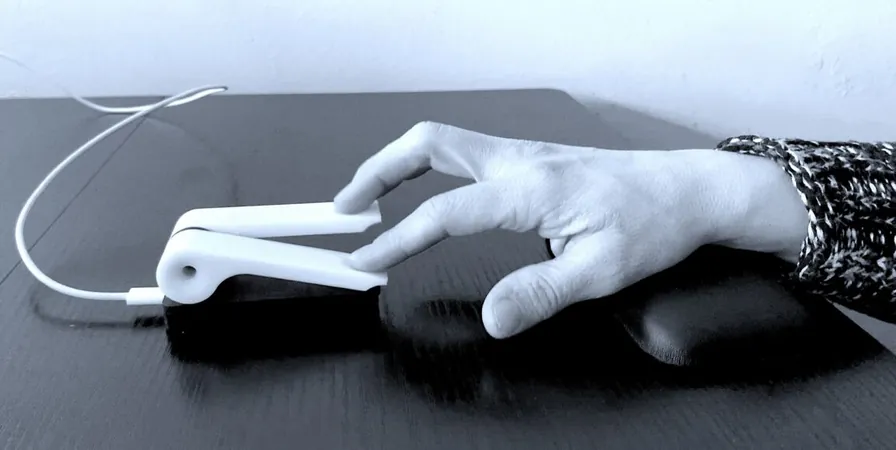
Revolutionary Technology Set to Transform Care for Parkinson's Patients
2024-09-23
Author: Arjun
Introduction
The global prevalence of Parkinson's disease has alarmingly doubled over the past quarter-century, impacting millions and highlighting an urgent need for effective care. Unfortunately, traditional methods for monitoring and treating this neurological disorder still rely largely on subjective assessments and face significant challenges, with many patients going extended periods without professional care.
Innovative Solution from Stanford Medicine
A promising new development from Stanford Medicine researchers offers hope. They have engineered a cutting-edge, portable device, along with a smartphone-platform, designed to allow patients to monitor their Parkinson's symptoms accurately and conveniently from home. Instead of outdated clinical ratings, which can vary from one evaluator to another, this innovative technology collects detailed data from simple finger presses, providing clinicians with a wealth of information that can guide remote treatment adjustments.
Research and Development
Dr. Helen Bronte-Stewart, a prominent figure in neurology at Stanford, spearheaded this initiative. The technology, comprised of the Digital Quantitative DigitoGraphy Care framework and the compact KeyDuo device, has shown great potential as outlined in two recently published research papers. Support for this project comes from multiple prestigious sources, including the Wu Tsai Neuroscience Institute and Stanford Medicine Catalyst, further validating its significance.
Challenges in Current Care
Current challenges in monitoring Parkinson’s disease progression include the reliance on in-person evaluations, which can be subjective and inconsistent. Furthermore, only about 40% of Parkinson's patients receive care from neurologists, creating a gap in managing this progressive illness that many struggle to navigate alone. This underscores the critical need for reliable and consistent monitoring tools.
Inception of the Device
The idea for such a device emerged unexpectedly during a clinic for performing artists suffering from dystonia—a condition affecting muscle control, particularly in musicians. One patient, a pianist with Parkinson's, demonstrated striking differences in symptoms when evaluated under varied medication regimens. The researchers realized that advanced monitoring could be applied using tension-engineered levers that assess not just the act of pressing but also the strength and speed of the movement.
Patient Empowerment with KeyDuo
With the new KeyDuo device, patients can now perform tests in the comfort of their homes, providing critical real-time data that transmits directly to their healthcare providers. The lightweight apparatus fits in the palm of the hand and connects seamlessly with smartphones for convenient use.
Effectiveness of the Technology
Recent studies have shown this technology can effectively monitor symptom fluctuations related to medication responses. In one revealing study, researchers followed eight patients over a month, achieving insights into their symptoms on a day-to-day basis. Another study even revealed the device's capability to detect involuntary tremors with a remarkable 98% sensitivity—an accomplishment that marks a significant step forward, as capturing such data has been historically challenging.
Impact on Parkinson’s Care
The introduction of this technology may usher in a new era of standardized care for Parkinson’s patients. By providing robust, objective data, physicians can develop more tailored treatment plans between infrequent clinic visits. This technology mirrors the impact continuous glucose monitoring has had on diabetes management. It empowers primary care physicians with necessary insights, transforming how they approach Parkinson’s care.
Future Implications
Not only does this innovation have the potential to improve daily management for patients, but it also holds promise for accelerating research into new treatments. With the ability to gather high-resolution data quickly and efficiently, clinical trials could be streamlined, leading to faster drug development at lower costs. This approach may substantially enhance accessibility and patient retention in trials, ultimately bringing new therapies to market more swiftly.
Conclusion
In conclusion, this groundbreaking technology represents a significant leap in managing Parkinson’s disease, promising improved patient experiences, enhanced care quality, and expedited research—all crucial in the ongoing battle against this debilitating condition.





 Brasil (PT)
Brasil (PT)
 Canada (EN)
Canada (EN)
 Chile (ES)
Chile (ES)
 Česko (CS)
Česko (CS)
 대한민국 (KO)
대한민국 (KO)
 España (ES)
España (ES)
 France (FR)
France (FR)
 Hong Kong (EN)
Hong Kong (EN)
 Italia (IT)
Italia (IT)
 日本 (JA)
日本 (JA)
 Magyarország (HU)
Magyarország (HU)
 Norge (NO)
Norge (NO)
 Polska (PL)
Polska (PL)
 Schweiz (DE)
Schweiz (DE)
 Singapore (EN)
Singapore (EN)
 Sverige (SV)
Sverige (SV)
 Suomi (FI)
Suomi (FI)
 Türkiye (TR)
Türkiye (TR)
 الإمارات العربية المتحدة (AR)
الإمارات العربية المتحدة (AR)